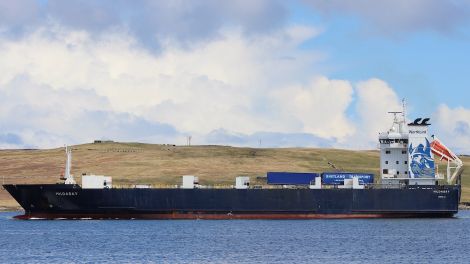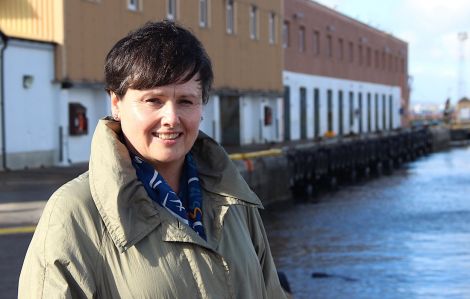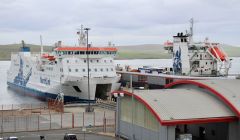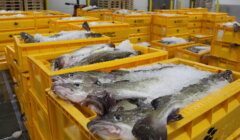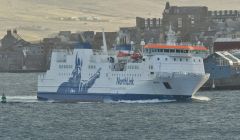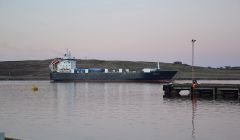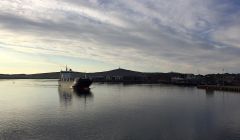Transport / Greater freight capacity urgently needed to support ‘thriving’ economy
Transport group study highlights that many sailings are at or near capacity
A GROUP formed to represent the interests of the seafood and haulage industries says that freight capacity in and out of the islands is “simply not meeting industry needs” with sailings frequently at or near capacity and is calling for an additional vessel to be chartered.
The islands’ Stewart Building Transport Group met Scottish Government transport minister Jenny Gilruth on Thursday (24 March) to present the findings of a study that it says found six in 10 northbound and four in 10 southbound sailings were running at “at least 90 per cent capacity, with one in ten over the allotted capacity”.
Its report concluded action is needed as soon as possible to make more freight capacity available to cater for Shetland’s “thriving” economy. It recommends chartering an extra freight vessel until whenever new vessels are introduced on the Northern Isles route.
Gilruth accepted an invitation to visit Shetland in person over the coming months to meet businesses and islanders and hear in detail about the particular challenges arising from the current restrictions in service.
The transport group has been raising concerns about capacity for some years and “very much welcomed the positive reception from the new minister”.
The group’s chairman, former Shetland MSP Tavish Scott, said that the volume of freight shipped between Lerwick and Aberdeen was “the highest earning route in the Scottish island ferry network, generating in excess of £10 million per year, the profits from which are fed back into the public purse”.
Become a member of Shetland News
“Despite this, it is often running at or over capacity and simply not meeting industry needs, which in turn impacts on the island’s economy and that of Scotland as a whole,” Scott said.
“The report clearly demonstrates that the service has not only reached capacity, there is absolutely no room for growth or, indeed, anywhere near adequate provision to handle peak periods or potential disruptions to service.”
The new study, conducted by AB Associates and SSQC, looked at current freight, volumes, projected volumes for 2022 and weekly freight patterns relating to shared services with Orkney.
The service has seen continued growth in freight year-on-year since 2016 – a trend set to continue with a generally buoyant economy and near full employment.
Sectors planning for growth include fish catching, aquaculture (both salmon and mussels) and tourism, which is expecting significant growth from the “staycation trend and greater use of motorhomes and caravans”. There are also new developments in decommissioning, renewables, the Orion project and Unst spaceport.
Potential for growth is “likely to be constrained by the availability of capacity on all routes”, the study warns, with evidence already emerging of demand being turned away particularly in the visitor market and oil and gas-related traffic.
Plans for a range of construction projects over the next decade will demand the transportation of materials.
Developments include over 500 new houses, a housing refurbishment programme, road improvements, power station redevelopment, a new hospital and school, fixed links and ferry infrastructure, two supermarkets and major energy project infrastructure.
The report identifies peak periods and days of the week where there is restricted space or no freight service, and the knock-on effects and costs this brings to hauliers and their customers.
Pointing to evidence of “pinch points and capacity issues” spreading throughout the year on all routes, the report recommends swift action to improve capacity, particularly in the autumn.
Another of the transport group’s members, Ruth Henderson, thanked those who contributed to the report, singling out Serco NorthLink Ferries which, the report noted, was felt by those interviewed to be doing “a good job in difficult circumstances”.
“The company staff were praised for their co-operation and flexibility regarding bookings, particularly their good communication and desire to accommodate the needs of various customers,” Henderson said.
“We were delighted to share these findings with the minister, and now look to the Scottish Government to help us to support the vibrant, thriving economy, producing not just for Shetland, but Scotland as a whole.”
A Transport Scotland spokesperson said in response: “The minister for transport met with hauliers to discuss the concerns of the industry and the importance of freight availability on lifeline services to and from the Northern Isles.
“We are developing plans for two new freight vessels that will be able to offer greater speed and capacity on the network, although these will take time to progress.
“In the meantime, we will continue to consider initiatives to increase access for time limited freight and continue to have CMAL explore the market for available tonnage that may be able to assist.
“To reduce capacity issues during the busiest period, additional sailings are already operating that will maintain peak freight service levels throughout the year.”
Become a member of Shetland News
Shetland News is asking its readers to consider paying for membership to get additional perks:
- Removal of third-party ads;
- Bookmark posts to read later;
- Exclusive curated weekly newsletter;
- Hide membership messages;
- Comments open for discussion.
If you appreciate what we do and feel strongly about impartial local journalism, then please become a member of Shetland News by either making a single payment, or setting up a monthly, quarterly or yearly subscription.






